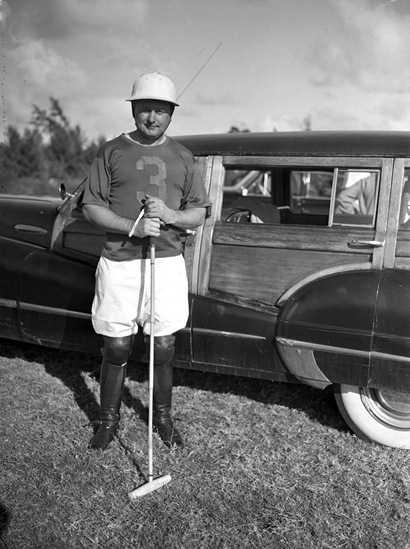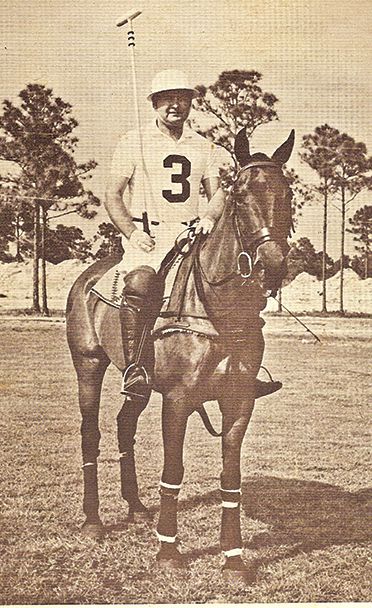Books by
Michael Barr
Order Here: |
|
|
A
Llano,
Texas cowboy became what many experts believe to be the best
polo player in the history of the game.
Cecil Calvert Smith was born on Valentine's Day, February 14, 1904,
on the Moss Ranch near Enchanted
Rock. Smith's father was the ranch foreman.
Smith learned to ride before he could walk. By age 16 he was a working
cowboy, breaking and training horses at the Moss Ranch for $40 a
month.
Then in 1925 Smith met George Miller, a horse trader from Austin.
Miller ran a livery stable and regularly bought horses in Llano
County. Miller also had a good business buying West Texas cow
horses, training them as polo ponies and selling them to wealthy
polo players in New York and California.
One day George Miller watched Cecil Smith and some friends playing
"cowboy polo." Miller could see that Smith had a way with horses,
and on his next trip to Llano
County, Miller hired Smith for $100 a month to train polo ponies.
In Austin Cecil Smith
met Rube Williams, another cowboy polo player from Llano.
Together they would make history.
Cecil Smith played a lot of polo while demonstrating George Miller's
horses. Smith impressed everyone with his horsemanship and athleticism.
He could hit a ball to the east while riding west. He was a fierce
competitor with a fearless style of play, but he was easy and graceful
in the saddle. He could swing like Babe Ruth and ride like Gary
Cooper.
Over the years his reputation grew. Then in 1933 Cecil Smith, Rube
Williams and a team of westerners played in the East-West Series
in Chicago. At that series of games, the Super Bowl of American
Polo, Cecil Smith made his mark.
|
 |
|
Cecil Smith
Photo courtesy State Library and Archives of Florida
|
|
The press billed
the game as the West Texas cowboys taking on the blueblood Eastern
establishment. One sportswriter described the game as "western men,
riding western horses against the polo manpower of Long Island and
the polo horseflesh of England and the Argentine."
The event transcended the sport and attracted worldwide attention,
even among people who had never seen a game of polo.
On paper the East team appeared invincible, but the cowboys didn't
read the papers. They were loose and supremely confident.
Still, the contest began on a sour note for the west squad. In the
first game Cecil Smith's horse fell on him, knocking him unconscious
for 30 minutes.
But Smith was a cowboy who had suffered far worse injuries busting
horses in Texas. Just as the ambulance arrived, Smith came to. He
waved the ambulance away, leaped on his horse and charged onto the
field to rejoin his teammates.
For the rest of the game Cecil Smith played brilliantly on both
ends of the field. His 95 yard wide angle shot put the West in the
lead.
Rube Williams was also in rare form that windy day in Chicago. He
rode so hard he knocked down the goal posts. There were so many
time outs for repairs and injuries, the 1 hour of playing time for
the first game stretched to 3 hours.
And Rube did not escape the carnage. In the first game a wild swing
from a mallet knocked him from his horse. In the second game he
broke his leg.
The Easterners were good, but the power polo played by the Westerners
overwhelmed their opponents. The West won the series and stunned
the polo world. As one reporter wrote, "The Easterners cracked under
the western hurricane like a slender reed in an 80-mile wind."
|
 |
|
Babe Ruth of
Polo - Cecil Calvert Smith
Photo courtesy the National Museum of Polo and Hall of Fame
|
|
After
that game Cecil Smith was the best known polo player in the world.
He earned a 10 goal handicap, the highest ranking in polo, and held
it for 25 years. His teams won the U.S. Open 7 times.
He played against politician and diplomat Averill Harriman and film
producer Darryl F. Zanuck. He was friends with Walt Disney, Will
Rogers and President Manuel Avila Camacho of Mexico, all avid polo
players.
Cecil Smith, the Babe Ruth of polo, retired to his ranch in Boerne
in 1967 and died there in 1999.
© Michael Barr
"Hindsights"
September 17, 2017 Column
Sources:
"Devils on horseback," San Antonio Express-News, December 4, 1976.
"Bunkhouse King of the Polo Field," Sports Illustrated, September
5, 1955, p 43.
|
|
|

 Gulf
Coast
Gulf
Coast East
Texas
East
Texas Central
North
Central
North Central
South
Central
South Panhandle
Panhandle South
Texas
South
Texas Hill
Country
Hill
Country West
Texas
West
Texas Ghost
Towns
Ghost
Towns COUNTIES
COUNTIES